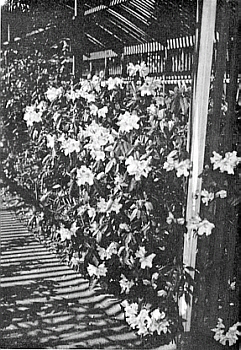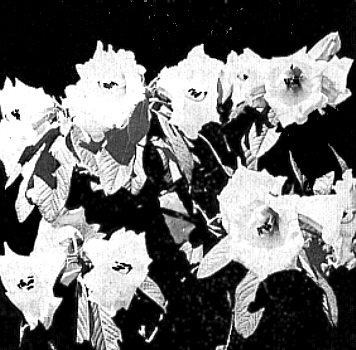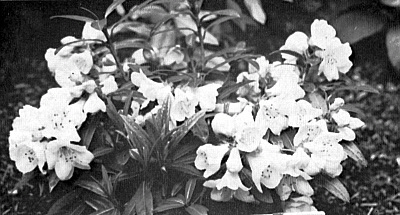California Rhododendron Introductions
Hadley Osborn , El Cerrito, Calif.
As visitors know, California's weather is usually unusual; and while in milder coastal areas it permits rhododendron enthusiasts to grow the whole range of the genus outdoors, it also puts unusual strains on plants used to harsher climates. Weather patterns are also surprisingly local, and conflicting reports about rhododendron behavior reflect a remarkable range of microclimates. Any statement that a particular rhododendron doesn't do well in coastal California's exceptionally long growing season of mild, wet winters and rainless summers is apt to be contradicted by a happy plant somewhere in the area.
Nonetheless, in milder gardens some alpines which have evolved in terms of a 3-4 month growing season tend to straggle irregularly into growth and bloom throughout the year. Given proper drainage they seldom die, but their health and habit suffer and kindhearted gardeners tend to put them out of their misery. The unhappy winter appearance of some dwarf species and hybrids also puts them in disfavor with gardeners accustomed to a lush green winter landscape. The most conspicuously dimorphic evergreen azaleas are less popular than fully evergreen varieties for the same reason.
Uncertain dormancy also causes some plants such as 'Elizabeth' to open aborted trusses throughout the winter. Such lax-trussed plants depend upon being covered with bloom for their effect and frequently too few buds are left to open normally. Even the dependable 'Jean Marie', successful in our colder gardens, has trouble in the mildest ones, with more than half the flower buds often failing to open at all. Other plants such as 'Vulcan' bloom normally but regularly break into growth first, even after having reached an age when they should have settled down.
The climate also produces unexpected problems. Flowers of some yellow hybrids appear several shades lighter than in the northwest. Factors governing the synthesis of color producing compounds are not yet understood, but since plants that have over-wintered in colder climates have bloomed with advertised intensity when brought to California it appears that lack of full dormancy may be at least partly responsible.
Then, a variety of reasons make some of the best known
R. williamsianum
hybrids difficult in California, where I have yet to see a well grown plant of 'Moonstone'. Plants in a variety of gardens under expert care steadily grow smaller through the years as a result of dieback - and again flower buds frequently fail to open. But there is no need to emphasize the negative. Like most local enthusiasts, I continue to grow 'Elizabeth', to make fresh starts with 'Moonstone', and to collect all available species - and some of the plants I've mentioned as difficult will turn out to be another Californian's favorites.
However, it is clear that the most carefree and ornamental rhododendrons for the area are those that have been hybridized or selected on the basis of their performance here. The first step in hybridizing for any eccentric climate is collecting and in the process a few plants that are already miraculously adapted emerge.

|

|
|
Fig. 52. 'Else Frye' one of the
good new California varieties. |
Fig. 54. 'Mi Amor' described in Mr. Osborn's
article. |
Thus, while collecting species in the Maddenii Series, Dr. and Mrs. Bowman of Fort Bragg purchased a
R. ciliicalyx
seedling from Else Frye. The plant soon showed that it had considerable blood of the now merged
R. edgeworthii
or
R. bullatum
, and it also soon proved to be an outstanding ornamental and was introduced as 'Else Frye' in 1961.
R. 'Else Frye' propagates readily and buds up immediately. The fragrant, 4" white flowers with a pink flush and yellow throat are clearly of the "Himalayan hybrid" type but are superior to those of the older hybrids. They have more substance than those of 'Fragrantissimum', for example, are more cleanly colored, and since they open earlier in cooler weather last much longer, and 'Else Frye' is much superior in plant habit, making a pleasing shrub throughout the year.
Several Californians are now raising hybrids of 'Else Frye'. A cross with
R. taronense
produced a clone introduced as 'Reine Long' in 1964 and, greatly similar, has the darker green leaf color of
R. taronense
but is tender in bud and plant. Mr. and Mrs. Maurice Sumner raised a population of selfed seedlings and produced one clone with considerably more color than its parent. The Sumners also selfed 'Forsterianum' (
R. veitchianum
x
R. edgeworthii
) and in a large population of indifferent seedlings raised one outstanding plant to be named 'Elegance', a name suited to the elegant poise of the large, white flowers.
It appears that a number of fine plants can be produced on this pattern; that is, by combining the floral quality and leaf character of
R. edgeworthii
with the superior habit and adaptability of the best of the Ciliicalyx Subseries; it is hoped that too many similar clones will not be introduced even though the best of them may all be superior to older hybrids of the type.
The Maddenii Series is so successful in coastal California that a special cup is provided at the Chapter Show for the best hybrid with both parents in that Series. An habitual winner is 'Mi Amor', the Sumners' cross of
R. lindleyi
x
R. nuttallii
. Almost overpowering in flower, the plant, with both parents in a Megacalyx Subseries not renowned for good habit, does require pruning to be at its best. The ungainly
R. rhabdotum
of this Subseries with its spectacularly striped flowers is now being greatly used in crosses, but most are resigned to at least a second generation to improve habit. The enduring popularity of 'Countess of Haddington' (
R. ciliatum
x
R. dalhousiae
) has led to crosses between more ornamental species of the Ciliicalyx and Megacalyx Subseries by several hybridists, and again it is hoped that too many similar clones, even if superior to their aristocratic forerunner, will not be named.
The Maddenii Series also provides excellent yellow color and plant habit in the best forms of
R. burmanicum
and
R. valentinianum
, and a number of outstanding dwarfish yellows have been raised. Across of 'Lucy Lou' (
leucaspis
x (
ciliatum
x
leucaspis
) and
R. valentinianum
produced several good plants for the Sumners. The best of them make, formal shrubs of immense character which bloom almost too heavily with light yellow flowers in March. One was registered as 'Little Lou' in 1964 and given a P. A. By selfing, the Sumners have produced another generation in which some seedlings show deeper yellow color, and they intend to name the best 'Baby Lou'.

|
|
Fig. 72.
R. tephropeplum
growing in the Test Garden in
Portland in 1961. Photo by Carl Phetteplace, M.D. |
Bob Scott has bred a remarkable plant on the same lines; that is, by crossing a smallish, tubular-flowered yellow with the flat-flowered
R. leucaspis
. His 'Lemon Mist' (
R. xanthostephanum
x
R. leucaspis
) makes an exceptionally pleasing, dwarfish plant, with a much better leaf, habit, and flower than
R. xanthostephanum
and with practically no dilution of color. Its interesting to note that
R. leucaspis
is aberrant in the Boothii Series in not having yellowish flowers (along, of course, with the variable and fairly distantly related pink-purple
R. tephropeplum
); and
R. leucaspis
appears to have a genetic make-up suitable for producing yellow in first generation hybrids. Mr. Scott also has one plant of an 'El Dorado' x
R. leucaspis
cross that is more yellow than its yellow parent. Strangely, there are not many
R. xanthostephanum
hybrids around, perhaps due to the species' discouraging habit of apomixes, but Howard Kerrigan has produced some interesting
R. xanthostephanum
and
R. chryseum
hybrids which are yellow-flowered plants of the 'Blue Diamond' type.
R. burmanicum
hybrids are also plentiful in the Bay Area. The Sumners 'Martha Wright' (
burmanicum
x 'Fragrantissimum') produces profuse and intensely fragrant cream flowers on a medium plant. Several have crossed
R. burmanicum
and 'Saffron Queen', with one plant of the Sumners, to be named 'Owen Pearce', appearing to be the most yellow and to be a much finer plant than 'Saffron Queen'.
All of these dwarf and medium yellows have excellent habit and their early season is particularly appreciated in a climate free from March-April frosts.
R. moupinense
and its hybrids are valued for the same reason, and the most outstanding one raised locally is Bob Scott's 'Pink Snowflakes' (
racemosum
x
moupinense
). This cross has been made elsewhere, but by using a clone sold locally as 'Pink Mist' and a form of
R. moupinense
with particularly good habit Mr. Scott has produced a tasteful dwarf that retains deep green leaves throughout the year in our gardens. Its crisp winter appearance with reddish buds clustered around the terminals would make it desirable even without its abundant show in late February of sparkling white flowers heavily flushed and spotted pink. John Druecker of Fort Bragg has also hybridized with
R. moupinense
, and a medium-dwarf clone distributed as 'Conchita' is winning praise for its pink flowers and chocolate-colored new growth.
Whether these early-blooming plants will be satisfactory in other areas remains to be seen, but one of the more conventional California introductions, 'Ruby Bowman', appears its usual dense, vigorous, and free flowering self in the Portland Test Garden. This
R. fortunei
x 'Lady Bligh' plant, hybridized by the Bowmans and raised and introduced by Mr. Druecker, is rated 5/4 and hardy to zero in
Rhododendron Information
. 'Stacia', another Druecker
R. fortunei
hybrid, this one with 'Everestianum', is another fine-foliaged plant with clean, blue-green leaves set off by red petioles and a rounded truss of pleasantly frilly flowers in mid-season.
Mr. Druecker has also raised several hybrids from 'Ruby Bowman'. A cross with
R. griersonianum
produced generally mediocre seedlings, but one, distributed as 'Lucy's Good Pink', takes full sun along the coast and blooms readily in mid-season with a big, fluorescent, salmon-pink truss. 'Ruby Bowman' x
R. elliottii
produced generally tawdry seedlings, but again one fine plant, a mid-season deep red with 24 flowers to a truss that is to be named 'Jim Drewry'. Mr. Druecker also put
R. elliottii
pollen on to 'Betty Wormald' and this time got seedlings of uniformly high quality, with the best introduced as 'Helen Druecker', an exceptionally large-flowered pink.
One of the best reddish-flowered plants for Californians is 'Noyo Chief'. This was purchased by the Bowmns as
R. arboreum kingianum
(now
R. zeylanicum
), and it, or a greatly similar clone, is still sold as
R. zeylanicum
in the northwest. 'Noyo Chief' differs, however, from the description of
R. zeylanicum
, and selfed seed has produced an appalling variety of plants. Whatever its parentage, everything about the vigorous, marvelously glossy-leaved 'Noyo Chief' radiates quality, and it is very happy in our climate, though needing protection from strong winds.
There are other California introductions which may also prove to be superior when they are more widely distributed. Here, as elsewhere, everyone is raising
R. yakushimanum
hybrids, but first generation results so far have been somewhat disappointing with the exception of Jock Brydon's 'Lurline' (
yakushimanum
x 'Unknown Warrior'). With Malesian rhododendrons being increasingly grown, hybrids are now being raised, but in spite of many attempts no successful crosses between Malesians and other rhododendrons have yet been verified. There does appear to be one major gap in local introductions thus far. Mr. Nearing, Mr. Gable and others have shown that by raising several generations of seedlings of a species not totally suited to a region, forms which are suited can be obtained. This has not yet been done in California, but with selfed seed of good forms now being made available through the ARS Seed Exchange and elsewhere, happy plants of species reported in past literature as difficult in our area may emerge.